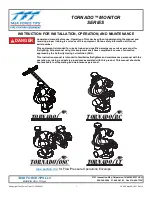
27
Section 3: Operating Instructions
4/20/15
RC3615 (540 RPM) and RCM3615 (1000 RPM) Rotary Cutters 330-502M
Disengage Blades
1.
Slowly decrease throttle speed until engine idle
speed is reached.
2.
Disengage PTO.
3.
Place tractor in park or set park brake, shut tractor
engine off, remove switch key, and wait for blades to
stop before dismounting from tractor.
Avoid Extreme Turning Angles
Refer to Figure 3-4 & Figure 3-5:
Plan your field cutting to minimize number of turns,
especially extreme turning angles. Avoid tractor-to-cutter
turning angles that exceeds driveline maximum turning
angle. If the turn cannot be avoided, disengage tractor
PTO and wait for the driveline to stop rotating before
making the turn.
•
Standard Conventional Driveline:
Maximum turning angle = 35
o
.
•
Constant Velocity Driveline:
Maximum turning angle = 80
o
.
Conventional U-Joint Driveline
Figure 3-4
Constant Velocity (CV) Driveline
Figure 3-5
11934
20795
General Operating Instructions
It is important that you familiarize yourself with the
Operator’s Manual, complete the Operator’s Checklist,
properly attach the cutter to your tractor, make leveling
adjustments, and preset your cutting height before
beginning a running operational safety check on your
Land Pride RC3615 or RCM3615 Series Rotary Cutter.
It’s now time to do a running operational safety check. It
is important that at any time during this safety check you
detect a malfunction in either the cutter or tractor that you
immediately shut the tractor off, remove the key, and
make necessary repairs and/or adjustments before
continuing on.
Before starting the tractor, make sure the park brake is
engaged, the PTO is disengaged, and the cutter is
resting on the ground with both wings down. Start the
tractor and set the engine throttle speed at a low idle.
Raise the cutter with the tractor’s rear hydraulic lift control
lever to transport position making sure that the PTO shaft
does not bind and does not contact the cutter frame.
Lower the cutter to the ground and at a low engine speed
engage the PTO. If everything is running smoothly at a
low idle, slowly raise the cutter to transport height
checking for bind or chatter in the driveline. Lower the
cutter to the ground and increase the tractor’s engine rpm
until it reaches the cutter’s full PTO operating speed
which will be either 540 or 1000 rpm. If everything is still
running smoothly, once more raise the cutter to transport
height to check for driveline bind or chatter. Lower the
cutter to the ground, return the engine to a low idle, and
disengage the PTO. Make a tight turn to ensure that the
rear tractor tires are not coming into contact with the hitch
or deck.
You should now be ready to transport to your cutting site
at a safe ground speed. On roadways, transport in such
a manner that faster moving vehicles can easily see you
and pass you safely. Reduce your speed when traveling
over rough and hilly terrain. Avoid quick or sharp steering
corrections. Take extra care to ensure that the mower
doesn’t come into contact with obstacles such as trees,
buildings, or fences. Use accessory lights and
appropriate reflective devices to provide adequate
warning to pedestrians and other vehicle operators when
traveling on public roads and in the dark of night. Comply
with all local, state and federal laws.
It is important that you inspect the area where you will be
cutting and clear it of safety hazards and foreign objects
either before or after you arrive at the cutting site. Never
assume the area is clear. Cut only in areas which you are
familiar with and are free of debris and unseen objects.
Extremely tall grass should be cut twice to detect
potential hazards. In the event you do strike an object
stop the cutter and tractor immediately to inspect and
make necessary repairs to the cutter before resuming
operation. It really pays to inspect a new area and to
develop a safe plan before cutting.
















































